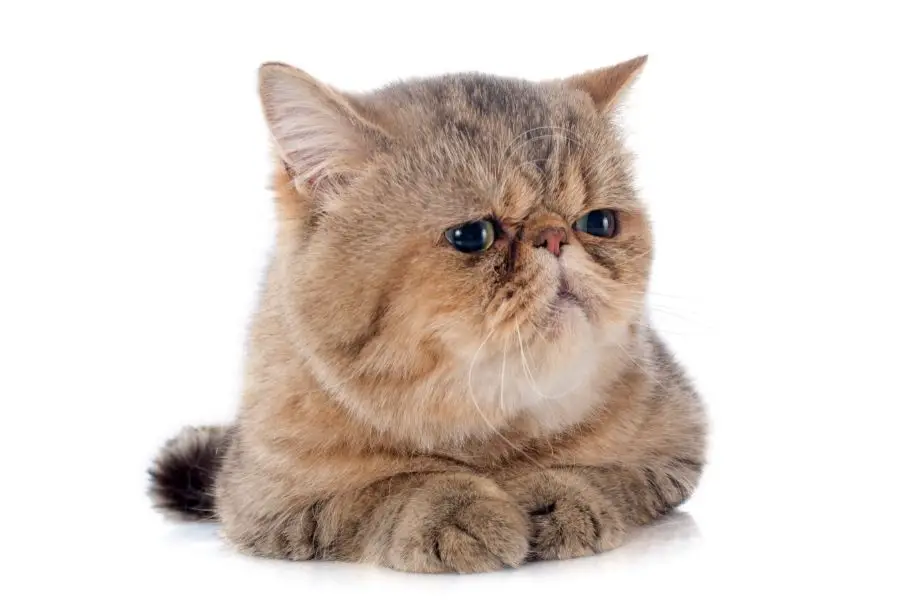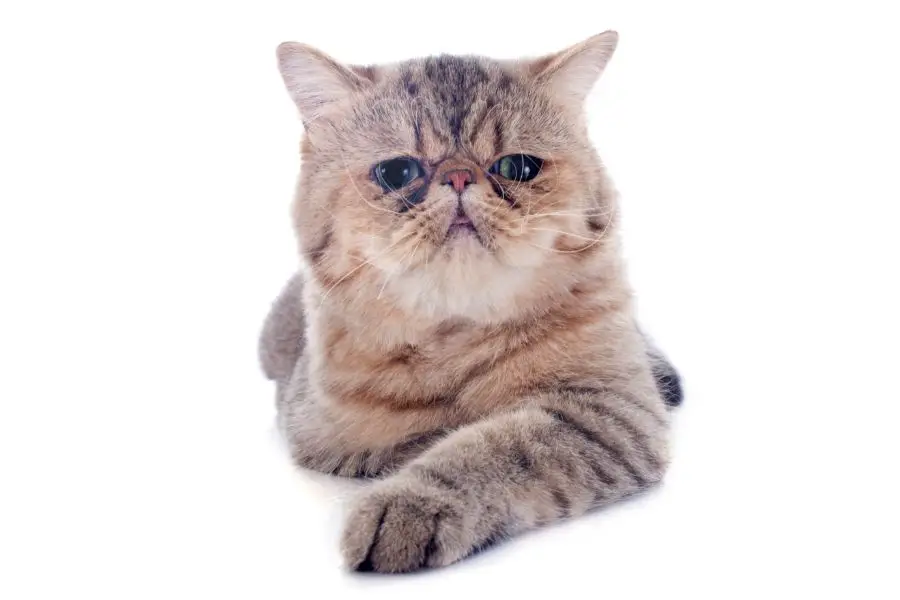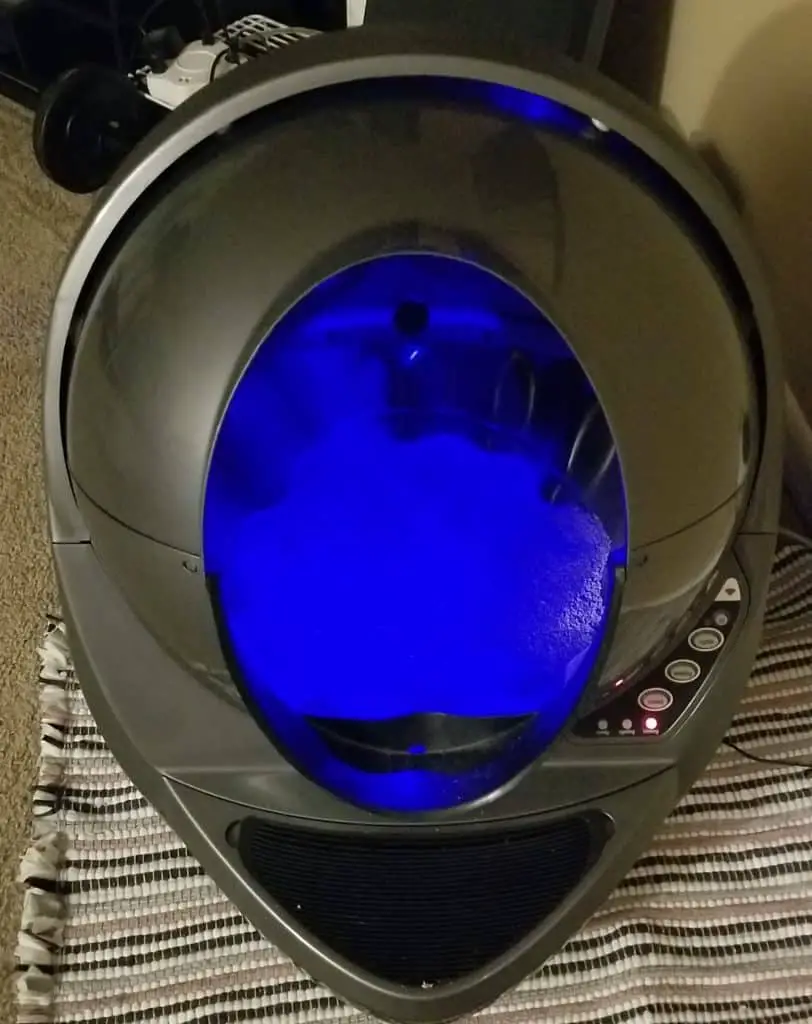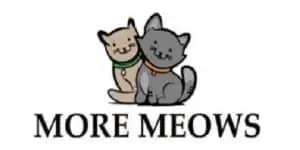More Meows is an Amazon Associate. As an Amazon Associate we earn from qualifying purchases. We may also earn commissions if you purchase products from other retailers after clicking on a link from our site.
An Exotic Shorthair breed has the same body and shape as a Persian cat, but the fur is significantly shorter, thus helping to cut down your cleaning and vacuuming time. But how much will Exotic Shorthairs grow?
Exotic Shorthairs are medium-sized cats that can grow to 12 inches long and weigh up to 12 lbs (5.44 kg). They have the same body size and face shape as the Persian breed but appear smaller due to having shorter hair. They can reach full growth size at about 12 months old.
This article will thoroughly explain:
- The growth of the Exotic Shorthair breed by examining the Exotic Shorthair Growth Chart.
- Potential health risks that can harm growth.
- What the compared growth is like with similar breeds.
- You will also learn more about how this breed came about and the typical life expectancy seen in Exotic Shorthairs.
After reading through this article, you will have a better understanding of the growth patterns of the Exotic Shorthair breed.
If you wonder what the best products are for your cat, check out this article that will break down all my recommendations for you: Things To Buy For A Cat Right Now!
Exotic Shorthair Growth Chart
The Exotic Shorthair breed growth is similar to its parent breeds, the Persian and American Shorthair. While some variations are unique to Exotic Shorthairs, it reflects a mixture of the two breeds.
Here is the Exotic Shorthair Growth Chart:
| Exotic Shorthair Growth Period | Details |
| Gestation | All cat breeds have a gestation period between 58 and 67 days. Since the exotic shorthair breed is still relatively new and there have not been many generations of breeding, there is a 1 in 4 possibility of an Exotic longhair kitten being born due to the recessive gene of the Persian breed. |
| Kitten | Kittens are typically weaned off their mother’s milk at around seven weeks of age. During the first seven weeks, growth can be rapid in kittens, starting at 3-5 oz (85-142 g) at birth and gaining about 0.35 oz (10 g) a day. |
| Adult | Around seven months of age, cat breeds will begin to undergo puberty and reach sexual maturity. Exotic shorthairs reach adulthood at around one year of age. |
| Mature | Exotic Shorthairs reach maturity at around three years of age. Males can weigh up to 12 lbs (5.44 kg), and females, slightly smaller, can weigh 10 lbs (4.5 kg). Unfortunately, as the breed grows into their full maturity, this can also put them at risk for potential health-related problems affecting their growth. |
Exotic Shorthair Health Problems

When an Exotic Shorthair reaches its fully-matured size, there are some potential health-related risks related to the specific breed that may need to be addressed during the growth and lifespan of the cat.
Let’s take a closer look at a few of the potential growth risks for the exotic shorthair breed.
Facial Structure Health Issues
Although exotic shorthairs have a distinctive and appealing face that has helped make the breed grow in popularity, the flat-faced structure can present breathing issues for these cats. BAOS, or Brachycephalic airway obstructive syndrome, affects dogs and cats with these similar facial structures.
The health risks can include trouble with breathing and an increased chance of the narrow airways becoming obstructed, causing sinus issues.
This can lead to a strain on the heart and other serious outcomes.
Other issues can include crooked teeth due to a smaller jaw, which may cause pain later in life and be examined by a veterinarian.
Feline Polycystic Kidney Disease
They can also be prone to urinary tract infections (UTIs), leading to a more severe condition called Feline polycystic kidney disease (PKD).
This illness is common in Persian breeds and can lead to severe and fatal risks such as kidney failure. A DNA screening for PKD can be conducted, and spaying and neutering are recommended for cats afflicted with the disease, which will help reduce the chance of the cat developing PKD.
Exotic Shorthair Growth Compared to Similar Breeds
Exotic shorthairs have some similarities to their parent breeds, resulting in breeding a Persian with an American Shorthair.
Initially, breeders wanted the Persian’s silver hair and green eyes, but with the American Shorthair’s build and frame. Breeders didn’t precisely achieve the desired results but were still satisfied with the exotic shorthair breed.
Exotic Shorthair vs Persian
A Persian cat will weigh up to 12 pounds, which places it at about the same weight as an Exotic Shorthair.
Having been around for centuries, with the first documented Persian cat being imported from Persia to Italy in the 17th century, this breed has had a few different variations throughout its time, including Himalayan and Exotic Shorthair breeds.
A trait shared with the Exotic Shorthair is the compact face, or “peke-face,” which refers to the similarity in the face of a Pekingese dog. The flat-faced look is distinctive in Persians and Exotic Shorthairs but also comes with serious health issues for both breeds.
Exotic Shorthair vs American Shorthair
Accepted as a pedigree cat breed by The International Cat Association, the American Shorthair breed is as old as the earliest settlers in North America.
These cats were kept on board the ships sailing from Europe to help control the mice and rat populations on board. They can weigh up to 15 lbs (6.8 kg), slightly larger than the Exotic, and reach their fully-matured growth between 3 and 4 years of age.
There are many different colors in the breed similar to Exotic Shorthairs, including:
- Black
- Brown
- Grey
- Mixed combinations
Exotic Shorthair Lifespan

You might be wondering, how long does an Exotic Shorthair Cat Live? With the Exotic Shorthair breed only being created about 50 years ago, the life expectancy of these cats ranges from as low as eight years up to 15 years.
The Exotic Shorthair breed has only been around for a short amount of time, and the ending results were not expected. To achieve the silver hair and green eyes of Persian cats, breeders initially mated an American Shorthair with a Persian.
They ended up with the Exotic Shorthair that you are familiar with today.
With these common ancestors, the life expectancy of exotic shorthair breeds is more of an average between Persians and American Shorthairs. A Persian breed’s life expectancy can be up to 13 years, and American Shorthairs have a longer life expectancy of 15 years or longer. Overall, the lifespan of exotic shorthairs is in line with all cat breeds in general, which have an average life expectancy of 15.1 years.
Depending on whether or not your Exotic Shorthair is an indoor or outdoor cat, this factor can have an effect on lifespan. An outdoor cat may not live as long as an indoor cat due to being exposed to:
- Elements of weather
- Humans
- Other animals
- Machinery
Conclusion
The growth of the Exotic Shorthair breed has similarities to its parent breeds, the Persian and the American Shorthair. However, the Exotic Shorthair is unique in its own way because it does not wholly share all of the traits from either breed but is a mixture of both.
Although a relatively new breed in the last 50 years, information on the growth of the Exotic Shorthair has become common knowledge in the cat world, you will have to see what the future holds for this interesting and unique breed.
If you are interested in reading more interesting articles, check out these:
- Exotic Shorthair vs American Shorthair (New Big Analysis): Click Here.
- Exotic Shorthair vs Scottish Fold (Compare The Best Cats!): Click Here.
- Do Exotic Shorthair Cats Scratch Furniture? (Full Analysis): Click Here.
Here are some of my favorite cat products
In addition to checking out some other More Meows articles, I hope you’ll check out some of my favorite cat products as well. These are affiliate links, so if you end up using them, I’ll get a commission at no extra cost to you. These are the products I really do find most helpful.
Litter Box: I started out with normal, traditional litter boxes for my cat. Then, I tried this automatic litter box on Amazon (affiliate link), which helped reduce the litter upkeep. Finally, I am now a believer in the Litter-Robot 3 Connect on Amazon (affiliate link). This robotic litter box is not for everyone based on the price tag, but for me the benefits (very little upkeep, works efficiently, clean, mobile app) far outweighed the cost.

Cat Tree: I have purchased a couple of this Amazon Basics Cat Tree on Amazon (affiliate link). My cat spends a lot of time on and around this cat tree, which I position near my sofa. She uses the scratching posts on this cat tree multiple times a day, which means she is not scratching the sofa instead.
Cat Water Fountain: I love this cat water fountain on Amazon (affiliate link). There are three main benefits to having a water fountain like this for your cat. The first benefit is that it keeps water running so that your cat doesn’t need to drink still water. The second benefit is that it filters the water. The third benefit is that it will keep your cat hydrated!
